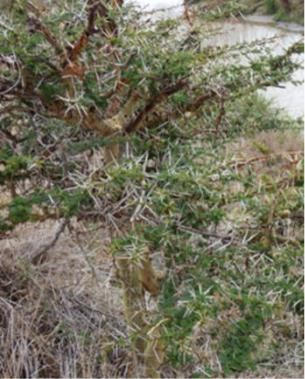I am a graduate student at Truman P. Young Lab. My research interest lies in wildlife conservation in anthropogenic landscapes. My current research delves into the intricate web of ecological interactions, specifically focusing on understanding how various ecological drivers shape soil microbial composition.
Through the generous support of a seed grant from Arms, courtesy of the Women in Conservation Technology (WiCT) program, I had the opportunity to expand my research horizons. This support allowed me to gather additional data, leading to the development of a manuscript that examines the fascinating realm of adaptive defense mechanisms. Currently under review, this work explores the dynamic strategies employed by species, particularly focusing on the resilient Acacia xanthophloea.
I am excited about the ongoing dialogue between my research and the broader field of conservation, and I look forward to sharing further insights as my work progresses.
Research Findings and Conclusion
 Against the semi-arid canvas Kenya's Mpala Research Centre, Acacia xanthophloea reveals a mesmerizing adaptation. Crafted hypotheses anticipate strategic adjustments in spine length and density. As we navigate fenced areas excluding megaherbivores, simulated browsing, and actual browsing scenario, indicating a dynamic response to simulated herbivory. Pruned branches exhibited significantly longer spines, a testament to the tree's adaptive response. Traversing tree heights, branches within herbivore reach showcase longer spines, emphasizing the adaptability of induced defenses in response to herbivore accessibility, while herbivore exclosures present trees with shorter spines, indicating relaxation of defense mechanism in the absence of browsing pressure.
Against the semi-arid canvas Kenya's Mpala Research Centre, Acacia xanthophloea reveals a mesmerizing adaptation. Crafted hypotheses anticipate strategic adjustments in spine length and density. As we navigate fenced areas excluding megaherbivores, simulated browsing, and actual browsing scenario, indicating a dynamic response to simulated herbivory. Pruned branches exhibited significantly longer spines, a testament to the tree's adaptive response. Traversing tree heights, branches within herbivore reach showcase longer spines, emphasizing the adaptability of induced defenses in response to herbivore accessibility, while herbivore exclosures present trees with shorter spines, indicating relaxation of defense mechanism in the absence of browsing pressure.
Acacia xanthophloea's dance with browsing pressure becomes a survival symphony. Every note resonates with the adaptability of these remarkable trees. The grand orchestra of nature showcases a dialogue between herbivores and plants, where each revelation deepens our appreciation for the intricate strategies sustaining balance and biodiversity. Acacia xanthophloea emerges not just as a symbol of survival but as a storyteller in nature's ongoing narrative.
WiCT Milestones
Since the WiCT meeting, I've secured a Ph.D. scholarship, presented at ICCB, and have a manuscript under review, advancing my contributions to wildlife conservation research. WiCT has been invaluable, shaping my journey and continuing to be an integral part of my growth.
What’s next?
Currently immersed in a Ph.D. program, I consider this academic journey a pivotal building block for the evolution of my research focus. Looking beyond my current work, my vision extends ambitiously. I am actively exploring opportunities to secure grants, propelling me into additional research endeavors. Concurrently, I am dedicated to expanding my skill set by pursuing training in eDNA methodologies, recognizing their significance in modern ecological research.
As I chart these future steps, my commitment extends to the continuous realization of my vision beyond the culmination of the Women in Conservation Technology (WiCT) program. WiCT, instrumental in providing support and fostering a community of passionate individuals, has equipped me with invaluable skills and insights. Leveraging this knowledge, I aspire to create a lasting impact in the realm of conservation. Exciting developments are anticipated on the horizon, marking the next chapter in my journey.
2 December 2023 9:16am
Big thanks to WiCT mentors


Mary Waithira